Black And Decker DR403 Handleiding
Black And Decker
Boormachine
DR403
Bekijk gratis de handleiding van Black And Decker DR403 (6 pagina’s), behorend tot de categorie Boormachine. Deze gids werd als nuttig beoordeeld door 53 mensen en kreeg gemiddeld 4.3 sterren uit 27 reviews. Heb je een vraag over Black And Decker DR403 of wil je andere gebruikers van dit product iets vragen? Stel een vraag
Pagina 1/6

•Use only accessories that are recommended by the manufacturer for your model.
Accessories that may be suitable for one tool, may become hazardous when used on
another tool.
SERVICE
•Tool service must be performed only by qualified repair personnel. Service or
maintenance performed by unqualified personnel could result in a risk of injury.
•When servicing a tool, use only identical replacement parts. Follow instructions in the
Maintenance section of this manual. Use of unauthorized parts or failure to follow
Maintenance Instructions may create a risk of electric shock or injury.
SPECIFIC SAFETY RULES
•Hold tool by insulated gripping surfaces when performing an operation where the
cutting tool may contact hidden wiring or its own cord. Contact with a "live" wire will
make exposed metal parts of the tool "live" and shock the operator.
WARNING: Some dust created by power sanding, sawing, grinding, drilling, and other
construction activities contains chemicals known to cause cancer, birth defects or other
reproductive harm. Some examples of these chemicals are:
• lead from lead-based paints,
• crystalline silica from bricks and cement and other masonry products, and
• arsenic and chromium from chemically-treated lumber. (CCA)
Your risk from these exposures varies, depending on how often you do this type of work. To
reduce your exposure to these chemicals: work in a well ventilated area, and work with
approved safety equipment, such as those dust masks that are specially designed to filter
out microscopic particles.
•Avoid prolonged contact with dust from power sanding, sawing, grinding, drilling, and
other construction activities. Wear protective clothing and wash exposed areas with
soap and water. Allowing dust to get into your mouth, eyes, or lay on the skin may promote
absorption of harmful chemicals.
WARNING: Use of this tool can generate and/or disburse dust, which may cause serious
and permanent respiratory or other injury. Always use NIOSH/OSHA approved respiratory
protection appropriate for the dust exposure. Direct particles away from face and body.
CAUTION: Wear appropriate hearing protection during use. Under some conditions
and duration of use, noise from this product may contribute to hearing loss.
The label on your tool may include the following symbols.
V ..........................volts A..........................amperes
Hz ........................hertz W ........................watts
min ........................minutes ......................alternating current
......................direct current no ........................no load speed
..........................Class II Construction
........................
earthing terminal
........................safety alert symbol .../min ..................revolutions or
reciprocations
per minute
First Aid Measures for Gel Components (DR220G Only)
If gel within the comfort grip becomes exposed and results in skin contact wash with soap
and water; for eye contact, flush with flowing water. If swallowed, seek medical attention.
Material Safety Data Sheet (MSDS) available from 1-800-544-6986.
SAFETY WARNINGS AND INSTRUCTIONS: DRILLS
•When drilling or driving into walls, floors or wherever live electrical wires may be
encountered, DO NOT TOUCH ANY METAL PARTS OF THE TOOL! Hold the tool only
by the plastic handle(s) to prevent shock.
• Do not lock the tool ON when drilling by hand. Refer to Operating Instructions-Switch.
•Hold drill firmly to control the twisting action of the drill. If your drill is equipped with a
side handle, always use the side handle.
General Safety Rules
WARNING: Read and understand all instructions. Failure to follow all instructions listed
below may result in electric shock, fire and/or serious personal injury.
SAVE THESE INSTRUCTIONS
WORK AREA
•Keep your work area clean and well lit. Cluttered benches and dark areas invite accidents.
•Do not operate power tools in explosive atmospheres, such as in the presence of
flammable liquids, gases, or dust. Power tools create sparks which may ignite the dust or
fumes.
•Keep bystanders, children, and visitors away while operating a power tool.
Distractions can cause you to lose control.
ELECTRICAL SAFETY
•Double insulated tools are equipped with a polarized plug (one blade is wider than the
other.) This plug will fit in a polarized outlet only one way. If the plug does not fit fully
in the outlet, reverse the plug. If it still does not fit, contact a qualified electrician to
install a polarized outlet. Do not change the plug in any way. Double insulation
eliminates the need for the three wire grounded power cord and grounded power supply
system.
•Avoid body contact with grounded surfaces such as pipes, radiators, ranges and
refrigerators. There is an increased risk of electric shock if your body is grounded.
•Don’t expose power tools to rain or wet conditions. Water entering a power tool will
increase the risk of electric shock.
•Do not abuse the cord. Never use the cord to carry the tools or pull the plug from an
outlet. Keep cord away from heat, oil, sharp edges or moving parts. Replace damaged
cords immediately. Damaged cords increase the risk of electric shock.
•When operating a power tool outside, use an outdoor extension cord marked "W-A"
or "W." These cords are rated for outdoor use and reduce the risk of electric shock.
PERSONAL SAFETY
•Stay alert, watch what you are doing and use common sense when operating a power
tool. Do not use tool while tired or under the influence of drugs, alcohol, or
medication. A moment of inattention while operating power tools may result in serious
personal injury.
•Dress properly. Do not wear loose clothing or jewelry. Contain long hair. Keep your
hair, clothing, and gloves away from moving parts. Loose clothing, jewelry, or long hair
can be caught in moving parts. Air vents cover moving parts and should be avoided.
•Avoid accidental starting. Be sure switch is off before plugging in. Carrying tools with
your finger on the switch or plugging in tools that have the switch on invites accidents.
•Remove adjusting keys or wrenches before turning the tool on. A wrench or key that is
left attached to a rotating part of the tool may result in personal injury.
•Do not overreach. Keep proper footing and balance at all times. Proper footing and
balance enables better control of the tool in unexpected situations.
•Use safety equipment. Always wear eye protection. Dust mask, non-skid safety shoes,
hard hat, or hearing protection must be used for appropriate conditions.
TOOL USE AND CARE
•Use clamps or other practical way to secure and support the workpiece to a stable
platform. Holding the work by hand or against your body is unstable and may lead to loss
of control.
•Do not force tool. Use the correct tool for your application. The correct tool will do the
job better and safer at the rate for which it is designed.
•Do not use tool if switch does not turn it on or off. Any tool that cannot be controlled with
the switch is dangerous and must be repaired.
•Disconnect the plug from the power source before making any adjustments,
changing accessories, or storing the tool. Such preventative safety measures reduce
the risk of starting the tool accidentally.
•Store idle tools out of reach of children and other untrained persons. Tools are
dangerous in the hands of untrained users.
•Maintain tools with care. Keep cutting tools sharp and clean. Properly maintained
tools, with sharp cutting edges are less likely to bind and are easier to control.
•Check for misalignment or binding of moving parts, breakage of parts, and any other
condition that may affect the tools operation. If damaged, have the tool serviced
before using. Many accidents are caused by poorly maintained tools.
VEA EL ESPAÑOL EN LA CONTRAPORTADA.
SAVE THIS MANUAL FOR FUTURE REFERENCE.
INSTRUCTIVO DE OPERACIÓN, CENTROS DE SERVICIO Y
PÓLIZA DE GARANTÍA. ADVERTENCIA: LÉASE ESTE
INSTRUCTIVO ANTES DE USAR EL PRODUCTO.
Catalog #’s DR201, DR202, DR211, DR220, DR220G, DR403, DR501, DR601
Form No. 630167-00 (JAN. 05) Copyright © 2005 Black & Decker Printed in China
Hammering position
Position de martelage
Posición de martillar
Drilling position
Position de perçage
Posición de taladrar
Lever
Levier
Palanca
CATALOG NUMBERS -
DR201, DR202, DR211, DR220,
DR220G, DR403, DR501, DR601
INSTRUCTION
MANUAL
3
3
3
3
3
3
3
3
3
3/
/
/
/
/
/
/
/
/
/8
8
8
8
8
8
8
8
8
8"
"
"
"
"
"
"
"
"
"
(
(
(
(
(
(
(
(
(
(1
1
1
1
1
1
1
1
1
10
0
0
0
0
0
0
0
0
0m
m
m
m
m
m
m
m
m
mm
m
m
m
m
m
m
m
m
m)
)
)
)
)
)
)
)
)
)
a
a
a
a
a
a
a
a
a
an
n
n
n
n
n
n
n
n
nd
d
d
d
d
d
d
d
d
d
1
1
1
1
1
1
1
1
1
1/
/
/
/
/
/
/
/
/
/2
2
2
2
2
2
2
2
2
2"
"
"
"
"
"
"
"
"
"
(
(
(
(
(
(
(
(
(
(1
1
1
1
1
1
1
1
1
13
3
3
3
3
3
3
3
3
3m
m
m
m
m
m
m
m
m
mm
m
m
m
m
m
m
m
m
m)
)
)
)
)
)
)
)
)
)
D
D
D
D
D
D
D
D
D
Dr
r
r
r
r
r
r
r
r
ri
i
i
i
i
i
i
i
i
il
l
l
l
l
l
l
l
l
ll
l
l
l
l
l
l
l
l
ls
s
s
s
s
s
s
s
s
s
a
a
a
a
a
a
a
a
a
an
n
n
n
n
n
n
n
n
nd
d
d
d
d
d
d
d
d
d
H
H
H
H
H
H
H
H
H
Ha
a
a
a
a
a
a
a
a
am
m
m
m
m
m
m
m
m
mm
m
m
m
m
m
m
m
m
me
e
e
e
e
e
e
e
e
er
r
r
r
r
r
r
r
r
r
D
D
D
D
D
D
D
D
D
Dr
r
r
r
r
r
r
r
r
ri
i
i
i
i
i
i
i
i
il
l
l
l
l
l
l
l
l
ll
l
l
l
l
l
l
l
l
ls
s
s
s
s
s
s
s
s
s
BEFORE RETURNING THIS PRODUCT
FOR ANY REASON PLEASE CALL
1-800-544-6986
IF YOU SHOULD EXPERIENCE A PROBLEM
WITH YOUR BLACK & DECKER PRODUCT,
CALL 1-800-544-6986
BEFORE YOU CALL, HAVE THE FOLLOWING INFORMATION AVAILABLE, CATALOG No., TYPE No.,
AND DATE CODE (e.g. 200205-47). IN MOST CASES, A REPRESENTATIVE CANBLACK & DECKER
RESOLVE YOUR PROBLEM OVER THE PHONE. IF YOU HAVE ASUGGESTION OR COMMENT, GIVE
US ACALL. YOUR FEEDBACK IS VITALTO BLACK & DECKER.
Switch Control Lever
Bouton de commande de l'in-
terrupteur
Palanca de control de inversión
Lock-on button
Bouton de verrouillage en position de marche
Botón de cierre para funcionamiento continuo 3
1
2
Trigger Switch
Interrupteur à gâchette
Interruptor de disparo
Hammering position
Position de martelage
Posición de martillar
Drilling position
Position de perçage
Posición de taladra
Lever
Levier
Palanca
7A
7B
Model DR403
Modèle DR403
Modelo DR403
Model DR601
Modèle DR601
Modelo DR601
6
Accessory Bit Holder
Porte-mèche
Sujetador de acceso-
rio de broca
45

WARNING: Drill may stall (if overloaded or improperly used) causing a twist. Always expect
the stall. Grip the drill firmly to control the twisting action and prevent loss of control which
could cause personal injury. If a stall does occur, release the trigger immediately and
determine the reason for the stall before re-starting.
• Always unplug the drill when attaching or removing accessories. When attaching accessories
in the drill chuck, it is important to securely tighten the chuck using all three holes to prevent
slippage. When using a keyless chuck, hand tighten firmly.
MOTOR
Be sure your power supply agrees with nameplate marking. 120 Volts AC only means your
drill will operate on standard 60 Hz household power. Do not operate AC tools on DC. A rating
of 120 volts AC/DC means that your tool will operate on standard 60 Hz AC or DC power. This
information is printed on the nameplate. Lower voltage will cause loss of power and can result
in over-heating. All Black & Decker tools are factory-tested; if this tool does not operate, check
the power supply.
USE OF EXTENSION CORDS
Make sure the extension cord is in good condition before using. Always use the proper size
extension cords with the tool – that is, proper wire size for various lengths of cord and heavy
enough to carry the current the tool will draw. Use of an undersized cord will cause a drop in
line voltage resulting in loss of power and overheating. For proper size cords see chart below.
ASSEMBLY/ADJUSTMENT SET-UP
WARNING: Always unplug drill from power supply before any of the following operations.
SIDE HANDLE (1/2" DRILLS ONLY)
• If your drill is equipped with a side handle, it must be installed properly to control the drill
• Insert bolt into recessed hole with molded hex shape, making sure that hex head is seated
fully to prevent bolt from turning.
• Place circular opening over drill chuck and onto front of drill gear case.
• Place the drill on its side and holding the bolt head with your finger, thread handle onto bolt.
The handle now has a full range of 360 degrees around the drill.
OPERATING INSTRUCTIONS
WARNING: To reduce the risk of serious personal injury, read, understand and follow all
important safety warnings and instructions prior to using tool.
WARNING: It is important to support the work properly and to hold the drill firmly to prevent
loss of control which could cause personal injury If you have any questions on how to
properly operate tool, call: 1-800-544-6986.
WARNING: Do not attempt to tighten drill bits (or any other accessory) by gripping the front
part of the chuck and turning the tool on. Damage to the chuck and personal injury may
occur when changing accessories.
FORWARD/REVERSE (DR202, DR201, DR211, DR220, DR220G, DR403, DR601)
To select forward rotation push the switch control lever to the RIGHT (when viewed from the
chuck end) (Fig.1). To select reverse push the lever to the (when viewed from the chuckLEFT
end). After all reversing operations, switch the tool to the forward running mode.
NOTE: WHEN THE SWITCH CONTROL LEVER IS IN THE CENTER POSITION THE DRILL
WILL NOT OPERATE. DO NOT FORCE TRIGGER. SELECT FORWARD OR REVERSE
BEFORE TURNING DRILL ON.
FORWARD/REVERSE (DR501)
To select forward rotation push the switch control lever to the LEFT (when viewed from the
chuck end) (Fig.1). To select reverse push the lever to the (when viewed from theRIGHT
chuck end). After all reversing operations, switch the tool to the forward running mode.
NOTE: WHEN THE SWITCH CONTROL LEVER IS IN THE CENTER POSITION THE DRILL
WILL NOT OPERATE. DO NOT FORCE TRIGGER. SELECT FORWARD OR REVERSE
BEFORE TURNING DRILL ON.
CHUCK & KEY OPERATION (DR501, DR601)
Turn chuck collar to open chuck jaws. Place bit in chuck as far as it will go. Tighten chuck collar
by hand. Place chuck key in each of the three holes, and tighten in clockwise direction (Fig. 2).
Tighten chuck with all three holes to prevent slippage.
KEYLESS CHUCK OPERATION
To attach accessories, grasp the rear half of the chuck with one hand and use your other hand
to rotate the front half in the counterclockwise direction as viewed from the chuck end shown in
Figure 3. Insert the bit or other accessory fully into the chuck, and tighten securely by holding
the rear half of the chuck and rotating the front portion in the clockwise direction.
QUICK CONNECTTM BIT CHANGE SYSTEM - (DR211,DR220, DR220G)
A unique feature of the DR211 and DR220 drills is the ability to remove the chuck quickly and
easily. This allows for a drill bit to be in the keyless chuck, while another accessory such as a
screwdriver bit, can be inserted into the Quick ConnectTM hex shaft at the same time.
To remove the chuck:
1. Grasp the drill and depress the two orange buttons on the chuck collar as shown in
Figure 4.
2. With the buttons depressed, pull straight out.
To replace the chuck:
1. Push the quick connect chuck straight on with a slight twisting motion until you hear it
click into place.
To insert a screwdriver bit into the Quick ConnectTM hex shaft, push the bit in until you hear it
click into place. To remove the bit, hold the drill as shown in figure 5. Push in evenly on the
spring loaded disc with two fingers and pull the bit straight out.
SWITCH
To turn the drill ON squeeze the trigger switch. The farther the trigger is depressed, the higher
the speed of the drill. To turn the tool OFF release the trigger switch. The drill can be locked
ON (maximum RPM only) for continuous use by squeezing the trigger while pushing in on the
locking button (Fig .1). Hold the locking button in while you release the trigger switch and then
release the locking button. The drill will continue to run. To turn the drill OFF from a locked ON
condition, squeeze and release the trigger.
WARNING: The drill should only be locked ON when it is held stationary in a drill press
stand or other means; NOT BY HAND! Never unplug the tool with the locking feature
engaged. To do so will cause the tool to start immediately the next time it is plugged in.
DRILLING
• Always unplug the drill when attaching or removing accessories. When attaching
accessories in the drill chuck, it is important to securely tighten the chuck using all three
holes to prevent slippage. When using a keyless chuck, hand tighten firmly.
• Use sharp drill bits only.
• Support and secure work properly, as instructed in the Safety Instructions.
• Use appropriate and required safety equipment, as instructed in the safety instructions.
• Secure and maintain work area, as instructed in the safety instructions.
• Run the drill very slowly, using light pressure, until the hole is started enough to keep the drill
bit from slipping out of it.
• Apply pressure in a straight line with the bit. Use enough pressure to keep the bit biting but
not so much as to stall the motor or deflect the bit.
• Hold the drill firmly to control its twisting action..
• DO NOT CLICK THE TRIGGER OF A STALLED DRILL OFF AND ON IN AN ATTEMPT TO
START IT. DAMAGE TO THE DRILL CAN RESULT.
• Minimize stalling on breakthrough by reducing pressure and slowly drilling through the last
part of the hole.
• Keep the motor running while pulling the bit out of a drilled hole. This will help reduce
jamming.
• Use a cutting lubricant when drilling metals. The exceptions are cast iron and brass which
should be drilled dry. The lubricants that work best are sulphurized cutting oil or lard oil.
Bacon grease will also serve.
• When using twist drill bits to drill holes in wood, it will be necessary to pull the bits out
frequently to clear chips from the flutes.
• Plug in drill. Make sure switch turns drill on and off.
KEYLESS CHUCK REMOVAL DR211, DR220, DR220G, DR403(DR201 DR202, , )
UNPLUG DRILL. Tighten the chuck around the shorter end of a hex key (not supplied) of 1/4"
(6.4mm) or greater size. Using a soft hammer, strike key sharply in a counterclockwise
direction (when viewed from the front of the tool). This will loosen the chuck so that it can be
unscrewed by hand.
KEYED CHUCK REMOVAL ( )DR501, DR601
UNPLUG DRILL. NOTE: Before attempting to remove chuck, shift the drill into the drilling
mode (not hammer, if so equipped).
Place chuck key in any one of the three holes in the chuck. Using a soft hammer, strike the
key in a clockwise direction. This will loosen the torx screw inside the chuck. Open chuck
jaws fully, insert a torx screwdriver into front of chuck between jaws to engage screw head.
Remove screw by turning clockwise (left-hand-thread). Place key in chuck. Using a soft
hammer, strike key sharply in a counterclockwise direction. This will loosen the chuck so that
it can be unscrewed by hand.
DRILLING IN WOOD
Holes in wood can be made with the same twist drill bits used for metal or with spade bits.
These bits should be sharp and should be pulled out frequently when drilling to clear chips
from the flutes.
DRILLING IN METAL
Use a cutting lubricant when drilling metals. The exceptions are cast iron and brass which
should be drilled dry. The cutting lubricants that work best are sulfurized cutting oil or lard oil;
bacon grease will also serve the purpose.
HAMMER ACTION (DR403, DR601)
Your drill has hammer action which is engaged by rotating the hammer/drill selector lever on
the top of the unit. To select hammering, turn off the drill and rotate the lever shown in either
Figure 7A or 7B so that the arrow on the lever points to to the hammer symbol on the drill
housing. To select drilling, turn off the drill and rotate the lever so that the arrow on the lever
points to the drill symbol.
DRILLING IN MASONRY (Shift drill into hammer mode as shown in Fig. 7A or 7B)
Use carbide tipped masonry bits. Refer to
Drilling
section. Keep even force on the drill but
not so much that you crack the brittle material. A smooth, even flow of dust indicates the
proper drilling rate.
DR601 ONLY:
CAUTION: Hold drill firmly to control the twisting action of the drill. If your drill is equipped
with a side handle, always use the side handle.
Under some conditions, when removing the drill bit from a masonry workpiece (with the drill
running) while drilling in the hammer mode, the transmission can be temporarily shifted into
the lower speed, higher torque drill mode. To control the unit in this condition, hold the drill
firmly, using both the main handle of the tool and the side handle. The unit is designed to
return to the hammer mode automatically as soon as the drill bit is cleared from the
workpiece; no change of the hammerdrill/drill selector lever position by the user is required.
MAINTENANCE
Use only mild soap and damp cloth to clean the tool. Never let any liquid get inside the tool;
never immerse any part of the tool into a liquid.
IMPORTANT: To assure product SAFETY and RELIABILITY, repairs, maintenance and
adjustment should be performed by authorized service centers or other qualified service
personnel, always using identical replacement parts.
ACCESSORIES
Recommended accessories for use with your tool are available from your local dealer or
authorized service center. If you need assistance regarding accessories, please call:
1-800-544-6986.
WARNING: The use of any accessory not recommended for use with this tool could be
hazardous.
SERVICE INFORMATION
Black & Decker offers a full network of company-owned and authorized service locations
throughout North America. All Black & Decker Service Centers are staffed with trained
personnel to provide customers with efficient and reliable power tool service.
Whether you need technical advice, repair, or genuine factory replacement parts, contact the
Black & Decker location nearest you. To find your local service location, refer to the yellow
pages directory under "Tools—Electric" or call: 1-800-544-6986.
FULL TWO-YEAR HOME USE WARRANTY
Black & Decker (U.S.) Inc. warrants this product for two years against any defects in material
or workmanship. The defective product will be replaced or repaired at no charge in either of
two ways.
The first, which will result in exchanges only, is to return the product to the retailer from whom
it was purchased (provided that the store is a participating retailer). Returns should be made
within the time period of the retailer’s policy for exchanges (usually 30 to 90 days after the
sale). Proof of purchase may be required. Please check with the retailer for their specific
return policy regarding returns that are beyond the time set for exchanges.
The second option is to take or send the product (prepaid) to a Black & Decker owned or
authorized Service Center for repair or replacement at our option. Proof of purchase may be
required. Black & Decker owned and authorized Service Centers are listed under
"Tools-Electric" in the yellow pages of the phone directory.
This warranty does not apply to accessories. This warranty gives you specific legal rights and
you may have other rights which vary from state to state. Should you have any questions,
contact the manager of your nearest Black & Decker Service Center. These products are not
intended for commercial use.
MAXIMUM RECOMMENDED CAPACITIES
Cat. # Type Steel Soft Wood Hard Wood Masonry
DR201 3/8"Drill 3/8"(10mm) Twist Bit 1-1/4"(31.7mm) 1"(25.4mm) N/A
DR202 3/8"Drill 3/8"(10mm) Twist Bit 1-1/4"(31.7mm) 1"(25.4mm) N/A
DR211 3/8"Drill 3/8"(10mm) Twist Bit 1-1/4"(31.7mm) 1"(25.4mm) N/A
DR220 3/8"Drill 3/8"(10mm) Twist Bit 1-1/4"(31.7mm) 1"(25.4mm) N/A
DR220G 3/8"Drill 3/8”(10mm) Twist Bit 1-1/4"(31.7mm) 1"(25.4mm) N/A
DR403 3/8"Hammer Drill 3/8"(10mm) Twist Bit 1-1/4"(31.7mm) 1"(25.4mm) 3/8"(10mm)
DR501 1/2"Drill 1/2"(12.7mm) Twist Bit 1-1/2"(38.1mm) 1-1/4"(31.7mm) N/A
DR601 1/2"Hammer Drill 1/2"(12.7mm) Twist Bit 1-1/2"(38.1mm) 1-1/4"(31.7mm) 1/2"(12.7mm)
See ‘Tools-Electric’
– Yellow Pages –
for Service & Sales
Black & Decker (U.S.) Inc.,
701 E. Joppa Rd.
Towson, MD 21286 U.S.A.
Minimum Gage for Cord Sets
Volts Total Length of Cord in Feet
120V 0-25 26-50 51-100 101-150
240V 0-50 51-100 101-200 201-300
Ampere Rating
More Not more American Wire Gage
Than Than
0 - 6 18 16 16 14
6 - 10 18 16 14 12
10 - 12 16 16 14 12
12 - 16 14 12 Not Recommended

poussière contenant des produits chimiques susceptibles d’entraîner le cancer, des
malformations congénitales ou pouvant être nocifs pour le système reproductif. Parmi ces
produits chimiques, on retrouve :
• le plomb dans les peintures à base de plomb,
• la silice cristalline dans les briques et le ciment et autres produits de maçonnerie,
• l’arsenic et le chrome dans le bois de sciage ayant subi un traitement chimique
(comme l’arséniate de cuivre et de chrome).
Le risque associé à de telles expositions varie selon la fréquence avec laquelle on effectue
ces travaux. Pour réduire l’exposition à de tels produits, il faut travailler dans un endroit bien
aéré et utiliser le matériel de sécurité approprié, tel un masque anti-poussières spécialement
conçu pour filtrer les particules microscopiques.
• Éviter tout contact prolongé avec la poussière soulevée par cet outil ou autres outils
électriques. Porter des vêtements de protection et nettoyer les parties exposées du
corps avec de l’eau savonneuse. S’assurer de bien se protéger afin d’éviter d’absorber
par la bouche, les yeux ou la peau des produits chimiques nocifs.
AVERTISSEMENT : Cet outil peut produire et répandre de la poussière susceptible de
causer des dommages sérieux et permanents au système respiratoire. Toujours utiliser un
appareil respiratoire anti-poussières approuvé par le NIOSH ou l’OSHA. Diriger les particules
dans le sens opposé du visage et du corps.
AVERTISSEMENT : Porter un dispositif de protection personnel anti-bruit approprié
durant l’utilisation. Sous certaines conditions et pendant toute la durée de l’utilisation,
le bruit émanant de ce produit pourrait contribuer à la perte d’audition.
DIRECTIVES ET CONSIGNES DE SÉCURITÉ : PERCEUSES
•Lors des opérations de perçage dans les murs, les planchers ou dans les endroits où
peuvent se trouver des fils sous tension, NE PAS TOUCHER LES PARTIES
MÉTALLIQUES DE L’OUTIL! Ne tenir l’outil que par la poignée en plastique pour
empêcher un choc électrique.
•Ne pas verrouiller l’outil en position de marche lors de l’utilisation de ce dernier en mode
manuel. Consulter la section intitulée Consignes d’utilisation – interrupteur.
•Tenir fermement la perceuse pour en commander la torsion. Si l’outil est équipé d’une
poignée latérale, toujours l’utiliser.
AVERTISSEMENT: La perceuse peut s’arrêter (si elle est surchargée ou elle n’est pas
correctement utilisée), ce qui peut entraîner la torsion de l’outil. Toujours s’attendre à l’arrêt
de l’outil. Tenir fermement la perceuse pour en commander la torsion et pour éviter d’en
perdre la maîtrise, ce qui peut causer des blessures. Si l’outil s’arrête, relâcher l’interrupteur
immédiatement et déterminer la cause de l’arrêt avant de recommencer.
•Toujours débrancher la perceuse lors de l’installation ou du retrait d’accessoires. Lorsqu'on
fixe des accessoires dans le mandrin de la perceuse, il est important de bien serrer le
mandrin à l’aide des trois ouvertures pour empêcher le décalage. Lorsqu’on utilise un
mandrin sans clés, bien serrer ce dernier à la main.
MOTEUR
S’assurer que l’intensité nominale du cordon d’alimentation correspond à celle indiquée sur
la plaque signalétique; sur cette dernière, la mention «120 V c.a.» signifie que la perceuse
ne doit être branchée que dans une prise résidentielle standard de courant
alternatif de 60 Hz et non pas dans une prise de courant continu, alors que «120 V c.a. /
c.c.» signifie que l’outil peut fonctionner sur une prise standard de 60 Hz de courant
alternatif ou continu. Ces renseignements sont indiqués sur la plaque signalétique. Une
tension inférieure à celle indiquée pourrait entraîner une perte de puissance et une
surchauffe. Tous les outils Black & Decker sont soumis à des essais en usine; si cet outil
ne fonctionne pas, on doit d’abord vérifier l’intensité nominale du cordon d’alimentation.
RALLONGES
Le cas échéant, s’assurer que la rallonge est en bon état avant de l’utiliser. Toujours utiliser
une rallonge qui convient à l’outil, c’est-à-dire dont le calibre des fils, la longueur du cordon
et les valeurs nominales correspondent à l‘outil alimenté. L’usage d’une rallonge de calibre
insuffisant pourrait causer une chute de tension entraînant une perte de puissance et une
surchauffe. Pour s’assurer qu’on utilise le calibre approprié, consulter le tableau ci-dessous.
Calibre minimum des rallonges
volts Longeur totale des rallonges en pieds
120V 0-25 26-50 51-100 101-150
240V 0-50 51-100 101-200 201-300
Intensité nominale
Minimum Maximum AWG (American Wire Gage)
0 - 6 18 16 16 14
6 - 10 18 16 14 12
10 - 12 16 16 14 12
12 - 16 14 12 Non pas recommandé
ASSEMBLAGE ET RÉGLAGE
AVERTISSEMENT: Toujours débrancher la perceuse de l'alimentation électrique avant
d’effectuer les opérations suivantes :
POIGNÉE LATÉRALE (PERCEUSES DE 1/2 PO SEULEMENT)
•Si la perceuse est équipée d'une poignée latérale, elle doit être bien installée pour pouvoir
commander l’outil.
•Insérer le boulon dans le trou encastré en forme hexagonale moulée, tout en vérifiant que
la tête hexagonale du boulon est bien enfoncée pour que le bouton ne se tourne.
•Placer l’ouverture circulaire sur le mandrin de la perceuse et sur la partie avant du carter
d’engrenages de la perceuse.
•Mettre la perceuse sur le côté. Tenir la tête du boulon et visser la poignée sur le bouton. La
poignée peut maintenant être tournée de 360 degrès autour de la perceuse.
CONSIGNES D’UTILISATION
AVERTISSEMENT: Afin de réduire les risques de blessure grave, lire, comprendre et
suivre toutes les consignes de sécurité et d'utilisation importantes avant d’utiliser l’outil.
AVERTISSEMENT: Il est important de bien soutenir l’ouvrage et de saisir fermement la
perceuse pour éviter d’en perdre la maîtrise, ce qui peut causer des blessures. Si vous avez
des questions portant sur l’utilisation de l’outil, composez le : 1-800-544-6986.
AVERTISSEMENT: Ne jamais serrer les mèches (ou tout autre accessoire) en tenant la
partie avant du mandrin et en démarrant l’outil. Le mandrin peut être endommagé et des
blessures peuvent être entrainées lors du changement des accessoires.
ROTATION AVANT/ARRIÈRE (DR202, DR201, DR211, DR220, DR220G, DR403, DR601)
Pour sélectionner la rotation avant, glisser le bouton de commande de l’interrupteur vers la
DROITE (vu à partir de la partie mandrin) (fig. 1). Pour sélectionner la rotation arrière, gliss-
er le bouton de commande vers la (vu à partir de la partie mandrin). Après avoirGAUCHE
terminé toute opération de rotation arrière, régler l’outil au mode de marche en avant.
AVIS : LORSQUE LE BOUTON DE COMMANDE DE L’INTERRUPTEUR EST RÉGLÉ À LA
POSITOIN CENTRALE, LA PERCEUSE NE FONCTIONNE PAS. NE PAS FORCER L’IN-
TERRUPTEUR. SÉLECTIONNER LA ROTATION AVANT OU ARRIÈRE AVANT DE
DÉMARRER LA PERCEUSE.
ROTATION AVANT/ARRIÈRE (DR501)
Pour sélectionner la rotation avant, glisser le bouton de commande de l’interrupteur vers la
GAUCHE (vu à partir de la partie mandrin) (fig. 1). Pour sélectionner la rotation arrière, gliss-
er le bouton de commande vers la DROITE (vu à partir de la partie mandrin). Après avoir ter-
miné toute opération de rotation arrière, régler l’outil au mode de marche en avant.
AVIS : LORSQUE LE BOUTON DE COMMANDE DE L’INTERRUPTEUR EST RÉGLÉ À LA
POSITOIN CENTRALE, LA PERCEUSE NE FONCTIONNE PAS. NE PAS FORCER L’IN-
TERRUPTEUR. SÉLECTIONNER LA ROTATION AVANT OU ARRIÈRE AVANT DE
DÉMARRER LA PERCEUSE.
UTILISATION DU MANDRIN ET DE LA CLÉ (DR501, DR601)
Tourner le collier du mandrin pour ouvrir les mâchoires de serrage du mandrin. Insérer la
mèche dans le mandrin le plus possible. Serrer le collier du mandrin à la main. Insérer la clé
du mandrin dans chacune des ouvertures et serrer dans le sens horaire (fig 2). Serrer le
mandrin à l’aide des trois ouvertures pour empêcher le décalage.
UTILISATION DU MANDRIN SANS CLÉS
Pour fixer des accessoires, tenir la partie arrière du mandrin à l’aide d’une main et utiliser
l’autre main pour tourner la partie avant vers la gauche (vu à partir de la partie mandrin
illustrée à la figure 3). Insérer la mèche ou tout autre accessoire dans le mandrin et serrer
bien en tenant la partie arrière du mandrin et en tournant la partie avant dans le sens horaire.
MESURES DE SÉCURITÉ
AVERTISSEMENT : Lire et comprendre toutes les directives. Le non-respect de toutes
les directives suivantes présente des risques de secousses électriques, d'incendie ou de
blessures graves.
CONSERVER CES MESURES.
ZONE DE TRAVAIL
• S'assurer que la zone de travail est propre et bien éclairée. Des établis encombrés et
des endroits sombres présentent des risques d'accidents.
• Ne pas utiliser des outils électriques en présence de vapeurs explosives (comme
celles dégagées par des liquides, des gaz ou des poussières inflammables). Les
étincelles générées par le moteur des outils électriques peuvent enflammer les poussières
ou les vapeurs.
• Éloigner les curieux, les enfants et les visiteurs de la zone de travail lorsqu'on utilise
un outil électrique. Une distraction peut entraîner la perte de maîtrise de l'outil.
MESURES DE SÉCURITÉ RELATIVES À L'ÉLECTRICITÉ
• Les outils à double isolation comportent une fiche polarisée (une lame plus large que
l'autre). La fiche n'entre que d'une façon dans une prise polarisée. Lorsque la fiche
n'entre pas à fond dans la prise, essayer de nouveau après avoir inversé les broches
de la fiche. Si la fiche n'entre toujours pas dans la prise, communiquer avec un
électricien certifié afin de faire installer une prise polarisée. Ne modifier en aucune
façon la fiche. La double isolation élimine le besoin d'un cordon trifilaire mis à la terre et
d'un système d'alimentation mis à la terre.
• Éviter de toucher à des surfaces mises à la terre comme des tuyaux, des radiateurs,
des cuisinières et des réfrigérateurs. Les risques de secousses électriques sont plus
élevés si le corps de l'utilisateur est mis à la terre.
• Protéger les outils électriques de la pluie ou des conditions mouillées. Une infiltration
d'eau dans l'outil augmente les risques de secousses électriques.
• Manipuler le cordon avec soin. Ne jamais se servir du cordon afin de transporter
l'outil ni tirer sur le cordon pour débrancher l'outil. Éloigner le cordon des sources de
chaleur, des flaques d'huile, des arêtes tranchantes et des pièces mobiles.
Remplacer immédiatement les cordons endommagés. Les cordons endommagés
augmentent les risques de secousses électriques.
• Lorsqu'on utilise un outil électrique à l'extérieur, se servir d'un cordon de rallonge
prévu pour l'extérieur, portant la mention "W-A" ou "W". Ces cordons sont conçus pour
servir à l'extérieur et minimisent les risques de secousses électriques.
SÉCURITÉ PERSONNELLE
• Demeurer vigilant, prendre soin et faire preuve de jugement lorsqu'on utilise un outil
électrique. Ne pas s'en servir lorsqu'on est fatigué ou affaibli par des drogues, de
l'alcool ou des médicaments. De graves blessures peuvent résulter d'un moment
d'inattention lors de l'utilisation d'un outil électrique.
• Porter des vêtements appropriés. Éviter de porter des vêtements amples ou des
bijoux. Recouvrir la chevelure si elle est longue. Éloigner les cheveux, les vêtements
et les gants des pièces en mouvement qui peuvent les happer.
• Éviter les démarrages accidentels. S'assurer que l'interrupteur est en position hors
tension avant de brancher l'outil. Afin d'éviter les risques de blessures, ne pas transporter
l'outil avec le doigt sur l'interrupteur ni brancher un outil dont l'interrupteur est en position
sous tension.
• Enlever les clés de réglage avant de mettre l'outil sous tension. Une clé qui est laissée
sur une pièce rotative de l'outil présente des risques de blessures.
• Ne pas dépasser sa portée. Garder son équilibre en tout temps. On s'assure d'une
meilleure maîtrise de l'outil dans des situations imprévues grâce à une position stable et un
bon équilibre.
• Porter de l'équipement de sécurité. Toujours porter des lunettes de sécurité. Dans
certaines conditions, il faut porter des masques respiratoires, des chaussures
antidérapantes, un casque de sécurité ou des protège-tympans.
UTILISATION ET ENTRETIEN DE L'OUTIL
• Utiliser des pinces de serrage ou de tout autre moyen pratique afin de fixer et de
soutenir la pièce à ouvrer sur une plate-forme stable. La pièce est instable lorsqu'elle
est retenue par la main ou le corps de l'utilisateur. Cela présente des risques de perte de
maîtrise de l'outil.
• Ne pas forcer l'outil. Utiliser l'outil approprié à la tâche. L'outil approprié fonctionne
mieux et sûrement lorsqu'on s'en sert à son rendement nominal.
• Ne pas se servir de l'outil lorsque l'interrupteur est défectueux. Le cas échéant, l'outil
est dangereux et il faut le réparer.
• Débrancher l'outil de la source d'alimentation avant de le régler, d'en remplacer les
accessoires ou de le ranger. On minimise de la sorte le risque de démarrage accidentel de
l'outil.
• Ranger l'outil hors de portée des enfants et de toute autre personne qui n'en connaît
pas le fonctionnement. L'outil est dangereux entre les mains de ces personnes.
• Prendre soin des outils. S'assurer que les outils de coupe sont tranchants et propres.
Des outils bien entretenus à arêtes tranchantes ont moins tendance à se coincer et ils se
maîtrisent mieux.
• Vérifier l'alignement et les attaches des pièces mobiles, le degré d'usure des pièces
ainsi que tout autre facteur susceptible de nuire au bon fonctionnement de l'outil.
Faire réparer un outil endommagé avant de s'en servir. Des outils mal entretenus sont la
cause de nombreux accidents.
• Utiliser seulement les accessoires recommandés par le fabricant. Des accessoires qui
conviennent à un outil peuvent présenter des risques avec un autre outil.
ENTRETIEN
• Confier l'entretien de l'outil seulement à du personnel qualifié. Le non-respect de la
présente directive présente des risques de blessures.
• Lors de l'entretien de l'outil, utiliser seulement des pièces de rechange identiques.
Respecter les consignes relatives à l'entretien du présent guide d'utilisation. Il y a
risque de secousses électriques ou de blessures lorsqu'on utilise des pièces non autorisées
ou lorsqu'on ne respecte pas les consignes relatives à l'entretien.
MESURES DE SÉCURITÉ ADDITIONNELLES
• Saisir les surfaces isolées de l'outil lorsqu'on s'en sert là où il pourrait y avoir des fils
sous tension et lorsqu'il pourrait entrer en contact avec son propre fil. En cas de
contact avec un fil sous tension, les composantes métalliques à découvert de l'outil
deviendraient sous tension et l'utilisateur subirait des secousses électriques.
L’étiquette de l’outil peut comporter les symboles suivants.
V ....................................volts A..........................ampères
Hz ..................................hertz W ........................watts
min..................................minutes ......................courant alternatif
................................courant continu no ........................sous vide
....................................construction de classe II
........................
borne de terre
..................................symbole d´avertissement .../min ..................tours ou courses
à la minute
Premiers soins relatifs à la composition du gel (DR220G)
Si le gel à l’intérieur de la poignée ergonomique venait à se répandre et entrer en contact
avec la peau, laver cette dernière à l’eau savonneuse. En cas de contact avec les yeux,
rincer abondamment à l’eau claire. En cas d’ingestion, voir un médecin. Pour obtenir la
fiche toxicologique de ce produit (MSDS), téléphoner au 1-800-544-6986.
AVERTISSEMENT : Certains outils électriques, tels que les sableuses, les scies, les
meules, les perceuses ou certains autres outils de construction, peuvent produire de la
NUMÉROS DE CATALOGUE : DR201, DR202,
DR211, DR220, DR220G, DR403, DR501, DR601
GUIDE D'UTILISATION
P
P
P
P
P
P
P
P
P
Pe
e
e
e
e
e
e
e
e
er
r
r
r
r
r
r
r
r
rc
c
c
c
c
c
c
c
c
ce
e
e
e
e
e
e
e
e
eu
u
u
u
u
u
u
u
u
uc
c
c
c
c
c
c
c
c
ce
e
e
e
e
e
e
e
e
es
s
s
s
s
s
s
s
s
s
e
e
e
e
e
e
e
e
e
et
t
t
t
t
t
t
t
t
t
m
m
m
m
m
m
m
m
m
ma
a
a
a
a
a
a
a
a
ar
r
r
r
r
r
r
r
r
rt
t
t
t
t
t
t
t
t
te
e
e
e
e
e
e
e
e
ea
a
a
a
a
a
a
a
a
au
u
u
u
u
u
u
u
u
ux
x
x
x
x
x
x
x
x
x
p
p
p
p
p
p
p
p
p
pe
e
e
e
e
e
e
e
e
er
r
r
r
r
r
r
r
r
rf
f
f
f
f
f
f
f
f
fo
o
o
o
o
o
o
o
o
or
r
r
r
r
r
r
r
r
ra
a
a
a
a
a
a
a
a
at
t
t
t
t
t
t
t
t
te
e
e
e
e
e
e
e
e
eu
u
u
u
u
u
u
u
u
ur
r
r
r
r
r
r
r
r
rs
s
s
s
s
s
s
s
s
s
d
d
d
d
d
d
d
d
d
de
e
e
e
e
e
e
e
e
e
1
1
1
1
1
1
1
1
1
10
0
0
0
0
0
0
0
0
0
m
m
m
m
m
m
m
m
m
mm
m
m
m
m
m
m
m
m
m
(
(
(
(
(
(
(
(
(
(3
3
3
3
3
3
3
3
3
3/
/
/
/
/
/
/
/
/
/8
8
8
8
8
8
8
8
8
8
p
p
p
p
p
p
p
p
p
po
o
o
o
o
o
o
o
o
o)
)
)
)
)
)
)
)
)
)
e
e
e
e
e
e
e
e
e
et
t
t
t
t
t
t
t
t
t
d
d
d
d
d
d
d
d
d
de
e
e
e
e
e
e
e
e
e
1
1
1
1
1
1
1
1
1
13
3
3
3
3
3
3
3
3
3
m
m
m
m
m
m
m
m
m
mm
m
m
m
m
m
m
m
m
m
(
(
(
(
(
(
(
(
(
(1
1
1
1
1
1
1
1
1
1/
/
/
/
/
/
/
/
/
/2
2
2
2
2
2
2
2
2
2
p
p
p
p
p
p
p
p
p
po
o
o
o
o
o
o
o
o
o)
)
)
)
)
)
)
)
)
)
AVANT DE RETOURNER LE PRODUIT, PEU IMPORTE
LA RAISON PRIÈRE DE COMPOSER 1 800 544-6986
Product specificaties
| Merk: | Black And Decker |
| Categorie: | Boormachine |
| Model: | DR403 |
Heb je hulp nodig?
Als je hulp nodig hebt met Black And Decker DR403 stel dan hieronder een vraag en andere gebruikers zullen je antwoorden
Handleiding Boormachine Black And Decker

26 Augustus 2024

26 Augustus 2024

10 Juni 2024

17 Augustus 2023

20 Juni 2023

18 Juni 2023

18 Juni 2023

17 Juni 2023

16 Juni 2023

16 Juni 2023
Handleiding Boormachine
- RUKO
- Goon
- Full Boar
- Kraftronic
- Topcraft
- Batavia
- Steren
- Milwaukee
- Robust
- Cecotec
- Bavaria
- Hyundai
- Daewoo
- Blucave
- Workzone
Nieuwste handleidingen voor Boormachine
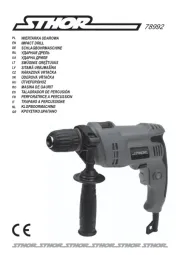
13 September 2025
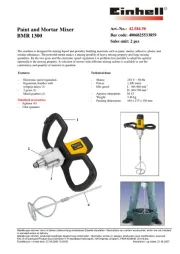
13 September 2025
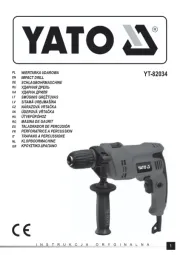
12 September 2025
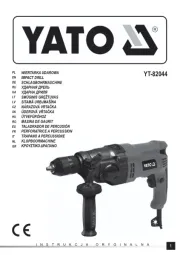
12 September 2025
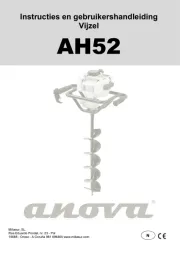
9 September 2025
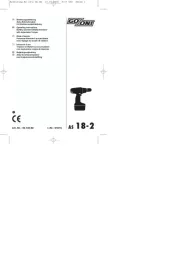
8 September 2025
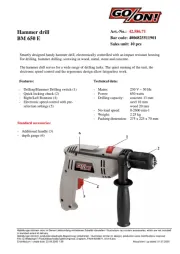
7 September 2025
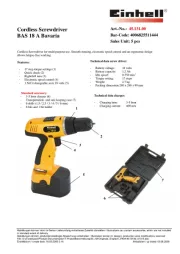
2 September 2025
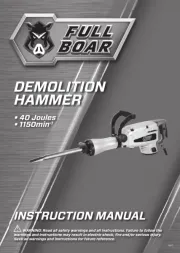
2 September 2025
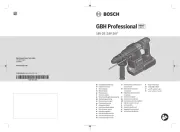
2 September 2025